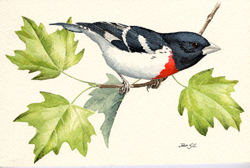Breeding Bird Atlases (BBA)
Find a Bird - BBA1
Breeding Bird Atlas 1 Species Accounts
Rose-breasted Grosbeak
Pheucticus ludovicianus
Egg Dates
May 22 to June 11
Number of Broods
one

Rose-breasted Grosbeaks are widespread breeders throughout Massachusetts in deciduous and mixed woodlands, in edge habitats, sometimes near water, and more recently in shade trees of parks and suburbs. The exception is the southeastern coastal plain, where they rarely nest. Forbush noted that: “Its numbers, however, fluctuate; it may appear commonly for a few years in a section and then suddenly become rare.”
Soon after the first of May, we look forward to seeing the first really colorful spring migrants—Northern Orioles, Scarlet Tanagers, Indigo Buntings, and the handsome male Rose-breasted Grosbeaks, unmistakable in their black and white plumage with a rose red triangle on the upper breast. Occasionally, a few will arrive during the latter days of April, but the majority of migrants, both male and female, pass through our area to other more northerly breeding grounds during the last two weeks of May. By mid-May, the resident males have established territories and attracted mates.
The beautiful song of the male is heard commonly in late May and throughout June. It bears some resemblance to the robin’s song but is much more musical and the varied phrases are longer. The call note, a sharp but penetrating metallic eeek, is easily recognized, and there is an alarm note that is similar but louder. Courtship can be quite spectacular, and anyone who has ever seen several males displaying before a female never forgets the sight of the males’ spread, lifted, quivering wings showing the rose-colored underwing coverts to best advantage.
Both sexes share in nest building. The nest is generally 6 to 15 feet high (sometimes considerably more) and is a fairly fragile affair of small sticks, twigs, and other course material, lined with fine grasses and rootlets. A Springfield nest was being constructed on May 19 (CNR). Four state nests were located as follows: 1 at 4 feet in Elderberry; 2 at 10 feet in an unidentified shrub and hawthorn respectively; and 2 at 18 feet in an ash (EHF, CNR). Three to five pale, greenish blue and brown-speckled eggs are mostly incubated by the female. The male also regularly incubates, often singing while on the nest. It has been reported that the female also occasionally sings. When she is incubating, the male is always close by. Clutch sizes for 8 state nests were three eggs (4 nests), four eggs (3 nests), five eggs (1 nest) (DKW, CNR).
The young hatch in about two weeks, remain in the nest for almost another two weeks, and are fed by both parents with a variety of insects and some fruit and seeds. There is one brood yearly, but the late egg dates suggest that the birds may renest if the first attempt fails. Brood sizes for 3 state nests were two, three, and four young, respectively (CNR). In Massachusetts, nestlings have been recorded from June 9 to June 18 and fledglings from June 15 (a known fledge date) to July 19 (CNR, Meservey). Fledglings will come to backyard feeders with their parents for sunflower seeds, which are fed to them, often by the male alone, until they can manage by themselves. At this time, the young have a soft, slurred food call.
By the end of July, the family tends to disperse, with the adults undergoing a post-nuptial molt during August. When the male completes his molt into winter plumage, he is quite different looking than during the breeding season, although still easily recognizable with his rose breast. There are light markings on the head and back, the rose patch is paler, and the breast is flecked with black. The brown and white female looks much the same in summer and winter.
The fall migration, in late August and September, is never as noticeable as that in spring because the birds move inconspicuously out of and through our area on their way to wintering grounds in Central America and northern South America. Occasionally, the metallic call note is heard from migrants and is the only indication of their presence. Most Rose-breasted Grosbeaks are gone by the end of September. There are regular reports of one or two individuals seen into December and January, but few survive a severe winter, even at feeding stations.
Map Legend and Data Summary
Atlas 1 data collected from 1975-1979


Charlotte E. Smith



